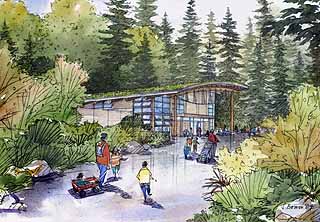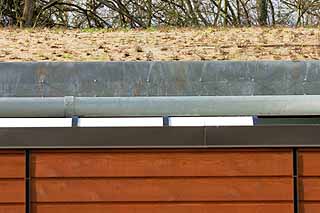
Surveys
DJC.COM
April 27, 2006
Putting a forest floor up on the roof at the zoo
Mithun

Zoomazium, learning place for families with young kids, will open next month at the Woodland Park Zoo.
|
Next month, a new vegetated roof will help teach kids about the native Northwest biome and how we can build in the city with less environmental impact.
Woodland Park Zoo's Zoomazium, an indoor learning place geared to families with children 2-8 years old, features a roof designed to work like and look like a segment of the forest floor.
It will have more than 22,000 native plants — including sword fern, salal, beach strawberry, nodding onion and blue eyed grass — and is about 8,000 square feet, or nearly twice the size of a basketball court.
The Zoomazium is located on the site of the former primate house, adjacent to the zoo's west entrance and the Rainforest Food Pavilion. The columns and truss design of the building were conceived as another room in the forest — with an arcade of columns and intentional transparency to blur the line between inside and outside.
Educational programs will be happening inside and outside, with views of both contributing to the overall experience.
Environmental footprint
Zoomazium embodies the zoo's mission of respecting the interconnectedness between nature, wildlife and people. Seventy-two percent of the wood used at Zoomazium is Forest Stewardship Council certified — harvested from sustainably managed forests — and the project is targeting a LEED silver rating.

Trees adjacent to Zoomazium provide shade from direct sunlight, reducing solar gain to the building.
|
The vegetated roof helps meet a range of goals, from reducing stormwater run-off and creating habitat to helping reduce the heat-island effect and airborne carbon pollution. At the same time it is educating new generations about how to build respectfully.
"The green roof is part of the zoo's commitment to demonstrating ecological responsibility in both the urban and the wild," says Deborah Jensen, zoo president and CEO.
Climate protection
Vegetated roofs can help protect climates from global warming, and here's how. Increasing vegetation helps reduce carbon in the air and helps lower overall temperatures in cities, where temperatures typically run higher because hard surfaces retain heat. Inspired by the Kyoto Protocol — an international commitment signed by 141 countries in 2005 — Mayor Nickels and the city of Seattle launched the U.S. Mayors Climate Protection Agreement to build and operate cities without adding more carbon to the atmosphere. More than 220 mayors, representing almost 45 million people, have agreed to meet or exceed the Kyoto Protocol goal of 7 percent carbon reduction by 2012.
Cities such as Malmo, Sweden, and Berlin have adopted policy strategies such as the Green Area Factor to help them achieve the goals of the Kyoto Protocol and limit their impacts on climate change. The Green Area Factor sets a standard that new projects must meet. Zoomazium exceeds Malmo's minimum standard through its combination of green walls, plantings and a vegetated roof.
Monitoring run-off
Water run-off rates from the roof will be monitored by Seattle Public Utilities, which is also gathering data over the next three years about the vegetated roof at the Ballard Library. Next year, Fire Station 10's green roof and a control site on a standard roof will be included in the monitoring.

Zoomazium’s vegetated roof will imitate a segment of forest floor when it grows out.
|
Dick Lilly, project leader for SPU says, "The zoo roof is going to provide us with some excellent information so we can determine, specifically for Seattle, to what degree do green roofs delay peak runoff and to what degree do they attenuate rainwater all together."
SPU will be working with a model based on research done in Portland and will be adapting it as data is gathered on these sites and as data is provided from other research such as Magnusson Klemencic's testing of five green roof samples in Seattle, and a study by the British Columbia Institute of Technology. Both are completing their first year of information early this summer.
This data will help SPU evaluate ways to support businesses and homeowners that put vegetated roofs on their buildings.
The ideas being tried on the roof are more likely to be applied elsewhere if it can be shown how they save money and reduce pollution. For example, when rainwater is captured by vegetated roofs, pipe sizes can be reduced, lowering infrastructure costs — and those savings could potentially be passed on to consumers.
Vegetated roofs also reduce pollution in Puget Sound. Since Seattle's stormwater and sewage systems share the same pipe, big rains cause sewage to spill into the Sound (called combined sewer overflows or CSOs). When vegetated roofs retain water, fewer overflows happen. Parts of the South Lake Union neighborhood are now eligible to reduce their stormwater retention requirements by using a green roof because adequate pipe capacity in some areas reduces the danger of overflows.
A roof can teach
Woodland Park Zoo receives more than a million visitors a year. A weather station on the roof will be linked to real time data that kids can see down below. An interactive exhibit in "kid language" will explain the roof and its functions to kids and their families. The vegetated roof is part of the systems-based education Woodland Park Zoo offers all of its visitors.
How it was built
Recreating a piece of the forest floor 20 feet up in the air started with establishing the structural requirements. The interior exhibit space is designed without support columns so that exhibits can be changed easily. Steel and wood trusses, a signature design element in the building, carry the load of the vegetated roof across the open exhibit space.
The soils and plants are set on a shallow curving form over the top of a waterproof membrane and root barrier layer. A drainage mat system shaped like a plastic egg carton helps hold soil and plants in place and allows for a balance of drainage and the moisture plants need.
Because the roof aims to mirror the adjacent forest floor, a 6-inch soil depth was used to allow for larger native plants such as the sword fern and salal. Seattle's climate can support vegetated roofs as shallow as 1.5 inches, but to capture rainwater 3- to 8-inch soil depth is the most effective.
The soils and minerals must have the correct balance of organic matter and minerals — too much organic matter and the soils shrink and need to be replenished, not enough and the native plants struggle. The mineral material available locally is a white pumice, which provides nutrients, air flow and holds moisture, like the soil but without the weight.
The final layer under the plants is a coir blanket covering the soil layer, which looks like a sheet of brown butcher paper. The coir is made from coconut shells and will degrade over time. It serves multiple purposes. It prevents the lightweight pumice from blowing away, reduces weed growth, retains moisture and is an aesthetic cover to the white pumice that "polka dots" the soils.
Working like nature
The roof will require little maintenance. Seasonal change is embraced and nutrients from dead leaves will be allowed to replenish the soil. As the plants form a continuous mat, less weeding will be required.
Typical maintenance on a green roof is less than a standard roof and studies show that reduction in UV ray impact extends the life of a vegetated roof to nearly twice the expectation of a standard bituminous roof surface. No irrigation is provided, though sprinklers are available to help establish the plants and to respond to drought conditions.
When Mithun convened the landscape architects for the vegetated roofs of the Justice Center, Ballard Library and City Hall to debrief on "lessons learned," the topic turned to crows. Crows are a species that have adapted well to changes in the built environment and vegetated roofs are no exception. It's a prime place to hunt for grubs — a well stocked picnic table for crows laid out in the most inviting way.
Jim Maxwell, the zoo's project manager says, "It's nature. That's the way it is and we adapt to it," so for now the zoo's groundskeepers will go up occasionally to stick the 4-inch-pot-sized plants back in the ground until they become rooted enough that the crows look elsewhere.
The Zoomazium roof adapts to and mimics nature's systems, in ways both predictable and surprising. As Seattle grows, all urban surfaces — roofs, walls, ground, decks — will be opportunities to mimic and adapt to nature's systems and create a healthier quality of life in the city.
Deb Guenther, a principal at Mithun, is a landscape architect and urban designer.
Other Stories:
- Arsenic-eating ferns may clean up Puget Sound soils
- Is this as green as Seattle gets?
- Program catalogs our fading historic landscapes
- Veterans' cemeteries: an inspiration of place
- Creating an urban forest in Anchorage
- Using GIS as a tool to protect Puget Sound
- Site constrained? That's opportunity knocking
Copyright ©2009 Seattle Daily Journal and DJC.COM.
Comments? Questions? Contact us.